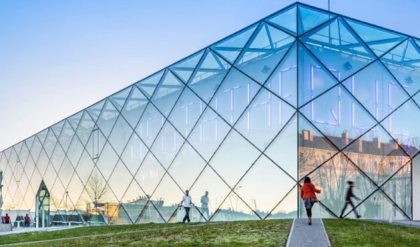The ground temperature under and next to a building is generally very close to the annual average temperature. This means that the temperature difference between the inside of most buildings and the ground is not that large, although it is much steadier. Hence, less insulation is needed to control heat flow to or from the ground. Nevertheless, some insulation is still required in many climates zones (DOE Zones 3 and higher). In many cases, heat flow control for slabs, crawlspaces, and basements is limited by that needed for control of moisture and comfort problems, not energy.

Figure 6: Temperature profile through the ground over the year in a cold climate location.
Air Leakage
If cold air leaks out of the building during cold weather, it is of course replaced with cold air. This cold air must be heated up to make it comfortable. In warm weather leaking air is replaced with hot air that needs to be cooled and dehumidified. The energy impact of air leakage is significant and must be considered since it is often an important heat loss/gain component of modern buildings. For example, air leakage can account for 30% of the thermal flow across the enclosure in a well-insulated modern home.
The use of a complete air barrier system is required to prevent unintentional air leakage. Several BSD’s and Guides address this critical issue.
Airflow can reduce or bypass thermal insulation in other ways than by just flowing across the enclosure.
Convective loops can form within highly air permeable insulation (low-density fibrous insulations) or small gaps around insulation (possible with rigid board insulation or improperly installed batts.

Figure 7: Convective air loops that reduce thermal control of insulation.

Figure 8: Wind-washing, the flow of wind through air permeable insulations,
can reduce the thermal performance of insulations.
Intentional ventilation has the same energy penalty as the same quantity of unintentional air leakage. Hence, the amount of ventilation should be no more than needed (see ASHRAE standards for guidance). In extreme climates, much of the energy required to heat/cool ventilation air can be recovered in heat recovery ventilator. Energy recovery ventilators also reduce the impact of humidity.
Solar Radiation Through Windows
Solar gain through windows exposed to either the direct sun, or reflected sun (reflected off the particles in the sky, creating diffuse radiation, or reflected off a surface) can dramatically affect the heat flow in a building. Hence, the building energy flows must account for the solar gain through windows. This amount of heat can dominate the performance of a modern building with relatively high window coverage (i.e., above 20 to 30% window to wall ratio).
The Solar Heat Gain Coefficient (SHGC) is the window property used to rate the amount of energy allowed through windows. The SHGC is the fraction of incident solar radiation that passes through a window and becomes heat inside the building. For example, if the SHGC of a glazing unit is 0.50, and the sun is shining on the window with an intensity of 500 W/m2, 250 W/m2 will enter the building.
The lower the SHGC, the less solar heat that the window transmits through and the greater its shading ability. In general, south-facing windows in houses designed for passive solar heating (with a roof overhang to shade them in the summer) should have windows with a high SHGC to allow in beneficial solar heat gain in the winter. East or west facing windows that receive large amounts of undesirable sun in mornings and afternoons, and windows in houses in hot climates, should have a low SHGC.
Solutions to control this form of thermal control include reduced window area, projecting horizontal shading (most effective on the south), exterior operable vertical shade, and solar control coatings on windows. Interior shades have a relatively small impact, but have the important role of controlling glare and providing privacy.
Passive solar heating design is used to capture the heat of the sun in a beneficial manner—this requires that most of the windows face south, and that window area be limited to collect only as much energy as needed for heating and to warm storage. Modern passive buildings have better control of the thermal losses in cold weather and hence have almost normal ratios of window to wall area.




Comments are closed.